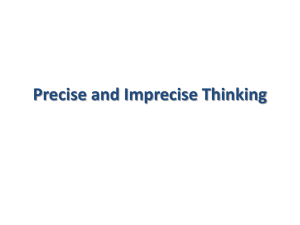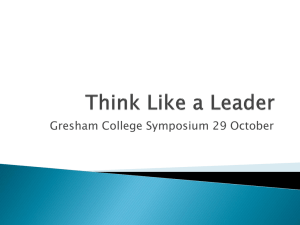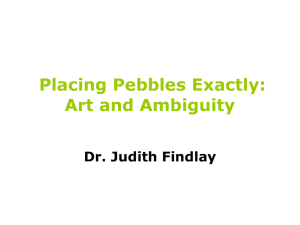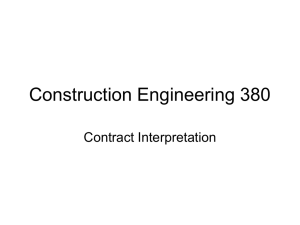Providing Integrated Toolkit-Level Support for Ambiguity in Recognition-Based Interfaces
advertisement
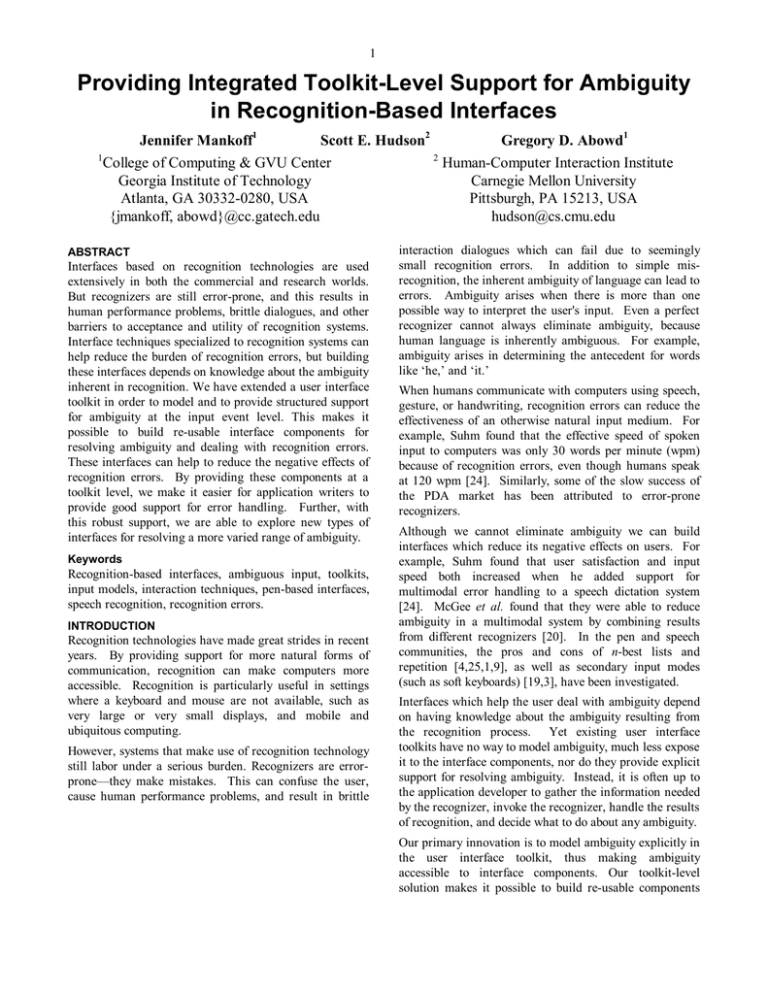
1
Providing Integrated Toolkit-Level Support for Ambiguity
in Recognition-Based Interfaces
Jennifer Mankoff1
1
Scott E. Hudson2
College of Computing & GVU Center
Georgia Institute of Technology
Atlanta, GA 30332-0280, USA
{jmankoff, abowd}@cc.gatech.edu
ABSTRACT
Interfaces based on recognition technologies are used
extensively in both the commercial and research worlds.
But recognizers are still error-prone, and this results in
human performance problems, brittle dialogues, and other
barriers to acceptance and utility of recognition systems.
Interface techniques specialized to recognition systems can
help reduce the burden of recognition errors, but building
these interfaces depends on knowledge about the ambiguity
inherent in recognition. We have extended a user interface
toolkit in order to model and to provide structured support
for ambiguity at the input event level. This makes it
possible to build re-usable interface components for
resolving ambiguity and dealing with recognition errors.
These interfaces can help to reduce the negative effects of
recognition errors. By providing these components at a
toolkit level, we make it easier for application writers to
provide good support for error handling. Further, with
this robust support, we are able to explore new types of
interfaces for resolving a more varied range of ambiguity.
Keywords
Recognition-based interfaces, ambiguous input, toolkits,
input models, interaction techniques, pen-based interfaces,
speech recognition, recognition errors.
INTRODUCTION
Recognition technologies have made great strides in recent
years. By providing support for more natural forms of
communication, recognition can make computers more
accessible. Recognition is particularly useful in settings
where a keyboard and mouse are not available, such as
very large or very small displays, and mobile and
ubiquitous computing.
However, systems that make use of recognition technology
still labor under a serious burden. Recognizers are errorprone—they make mistakes. This can confuse the user,
cause human performance problems, and result in brittle
LEAVE BLTHE LAST 2.5 cm (1”) OF THE LEFT
COLUMN ON THE FIRST PAGE FOR THE
COPYRIGHT NOTICE.
Gregory D. Abowd1
2
Human-Computer Interaction Institute
Carnegie Mellon University
Pittsburgh, PA 15213, USA
hudson@cs.cmu.edu
interaction dialogues which can fail due to seemingly
small recognition errors. In addition to simple misrecognition, the inherent ambiguity of language can lead to
errors. Ambiguity arises when there is more than one
possible way to interpret the user's input. Even a perfect
recognizer cannot always eliminate ambiguity, because
human language is inherently ambiguous. For example,
ambiguity arises in determining the antecedent for words
like ‘he,’ and ‘it.’
When humans communicate with computers using speech,
gesture, or handwriting, recognition errors can reduce the
effectiveness of an otherwise natural input medium. For
example, Suhm found that the effective speed of spoken
input to computers was only 30 words per minute (wpm)
because of recognition errors, even though humans speak
at 120 wpm [24]. Similarly, some of the slow success of
the PDA market has been attributed to error-prone
recognizers.
Although we cannot eliminate ambiguity we can build
interfaces which reduce its negative effects on users. For
example, Suhm found that user satisfaction and input
speed both increased when he added support for
multimodal error handling to a speech dictation system
[24]. McGee et al. found that they were able to reduce
ambiguity in a multimodal system by combining results
from different recognizers [20]. In the pen and speech
communities, the pros and cons of n-best lists and
repetition [4,25,1,9], as well as secondary input modes
(such as soft keyboards) [19,3], have been investigated.
Interfaces which help the user deal with ambiguity depend
on having knowledge about the ambiguity resulting from
the recognition process. Yet existing user interface
toolkits have no way to model ambiguity, much less expose
it to the interface components, nor do they provide explicit
support for resolving ambiguity. Instead, it is often up to
the application developer to gather the information needed
by the recognizer, invoke the recognizer, handle the results
of recognition, and decide what to do about any ambiguity.
Our primary innovation is to model ambiguity explicitly in
the user interface toolkit, thus making ambiguity
accessible to interface components. Our toolkit-level
solution makes it possible to build re-usable components
2
We have extended the user interface toolkit subArctic
[8,13] to provide explicit access to ambiguity at an input
level, and to provide support for resolving ambiguity
through the mediation subsystem. In particular, we have
populated the toolkit with some generic mediators that
handle a wide variety of types of input, output, and
ambiguity.
(a)
(b)
Figure 1: Two examples of a menu of possible
interpretations of the user's input. (a) The user is
dictating text. (b) The user is drawing a button in
Burlap, a user interface sketching tool based on
SILK[15].
and strategies for resolving ambiguity. It also allows us to
give the user feedback about how their input is being
interpreted before we know for sure exactly which
interpretation is correct. At the same time, by carefully
separating and structuring different tasks within the
toolkit, neither application nor interface need necessarily
know anything about recognition or ambiguity in order to
use recognized input, or to make use of predefined
interface components for resolving ambiguity.
Our secondary innovation is to support ambiguity and
recognition at the input level, so that objects receive
recognition results through the same mechanism as mouse
and keyboard events. This allows the application to make
use of recognized input without having to deal with it
directly or to rewrite any interface components. Our
approach differs from other toolkits that support
recognized input such as Amulet [16] and various
multimodal toolkits [20, 22]. These toolkits provide
varying amounts of support for ambiguity, but require the
application writer to deal with recognition results directly.
For example, consider a word-prediction application [2].
As the user types each character, the system tries to predict
what words may come next. Our toolkit's input system
automatically delivers any text generated by the word
predictor to the current text focus, just as it would do with
keyboard input. The text focus may not even know that a
word predictor is involved. If there is more than one
possible completion (the text is ambiguous), the toolkit
will maintain the relationship between the possible
alternatives and any interactive components using that
input. The toolkit will automatically pass the ambiguous
input to the mediation subsystem. This subsystem decides
when and how to resolve ambiguity. If necessary, it will
involve the user via interfaces that deal with mediation,
called mediators. For example, it may bring up an n-best
list, or menu, of alternatives from which the user can select
the correct choice (see Figure 1a).
In order to demonstrate the effectiveness of our ambiguityaware user interface toolkit, we have built Burlap, a
simplified version of the sketch-based user interface
builder, SILK (Sketching Interfaces Like Krazy [15]).
Burlap, like SILK, allows the user to sketch interactive
components (or what we will call interactors) such as
buttons, scrollbars, and checkboxes on the screen. Figure
1b shows a sample user interface sketched in Burlap. The
user can click on the sketched buttons, move the sketched
scrollbar, and so on. In this example, the user has drawn a
radiobutton which is easily confused with a checkbox. The
system has brought up a default mediator (the same as is
shown in Figure 1a), asking the user which interpretation
is correct.
The next section describes how ambiguous input is
modeled at the toolkit level. We then discuss how
ambiguity is handled at the user interface level, using
Burlap as a demonstration medium. Burlap illustrates
several types of ambiguity, makes use of mediators
provided by default in the toolkit, and also demonstrates
the benefits of being able to extend these mediators to take
advantage of application-specific information.
The
following section shows how our toolkit-level mechanisms
for hiding ambiguity from the application reduces the
burden of writing applications which use recognition. We
conclude with a description of the variety of recognizers
and mediators used in Burlap and some other very simple
applications we have built.
MODELING AMBIGUOUS INPUT
Existing user interface toolkits handle input from
traditional input sources by breaking it into a stream of
autonomous input events. Most toolkits determine a series
of eligible objects that may consume (use) each event. The
toolkit will normally dispatch (deliver) an event to each
such eligible object in series until the event is consumed.
After that, the event is not dispatched to any further
objects. Variations on this basic scheme show up in a wide
range of user interface toolkits.
In order to extend this model to handle recognized input,
we first need to allow the notion of an input source to be
more inclusive than in most modern user-interface toolkits.
Traditionally only keyboard and mouse (or pen) input is
supported. We allow input from any source that can
deliver a stream of individual events. In particular, we
have made use of input from a speech recognizer (each
time text is recognized, a new event is generated) and from
a context toolkit [23]. The context toolkit handles work of
3
Move
Down
Move
Move
Up
Down
Stroke
Up
Down
Text
Radiobutton
Down
Stroke
Stroke
Circle
Move
Up
Raw events
Interpreted
events
Figure 2: Two Mouse Strokes and the resulting
hierarchical events
Rect
Checkbox
Up
Stroke
Circle
Text
Radiobutton
Figure 3: Two Mouse Strokes and the
resulting hierarchical ambiguous events
Raw events
Interpreted
events
Ambiguous
events
gathering information from sensors and interpreting, or
abstracting it to provide information such as the identity of
users in a certain location (e.g., near the interface).
events from Figure 2 with the addition of recognizergenerated ambiguity. The circle, the rectangle, and any
interpretation of either are ambiguous.
The next step in supporting recognized input requires us to
track explicitly the interpretation and use of input events.
This is done using hierarchical events, which have been
used in the past in a number of systems (see for example
Green's survey [10] and the work by Myers and Kosbie
[21]). Hierarchical events contain information about
traditional input events (mouse or pen and keyboard) are
used, or in the case of recognition, interpreted. They can
be represented as a directed acyclic graph. Nodes in the
graph represent events. Arrows into a node show what
events it was derived from. Arrows out of a node show
what events were derived from it. Figure 2 shows what
this graph looks like when the user draws a radiobutton in
Burlap. This graph allows us to explicitly model the
relationship between raw events (such as mouse events),
intermediate values (such as strokes), derived values (such
as recognition results) and what the application does with
those values (such as create a radiobutton).
Just as in the unambiguous case, an ambiguous hierarchy
is generated as events are dispatched and consumed.
However, unlike most existing systems, we dispatch an
event to each consumer in sequence even after the event
has been consumed. If an event is consumed by more than
one consumer, or a consumer generates multiple
interpretations, ambiguity results.
Hierarchical events are generated by requiring each event
consumer to return an object containing information about
how it interpreted the consumed event [21]. For example,
the circle in Figure 2 was created by a gesture recognizer
that consumed the stroke the circle derived from and
returned the circle as its interpretation of that stroke. Each
derived interpretation becomes a new node in the graph.
Nodes are dealt with just like raw input events: they are
dispatched to consumers, which may derive new
interpretations, and so on.
Hierarchical events can also be used to model ambiguity
explicitly. Ambiguity arises whenever two events are in
conflict (both cannot be correct). For example, the gesture
recognizer from Figure 2 may return two possible
interpretations (a rectangle and a circle), only one of
which can be correct. Figure 3 shows the hierarchical
We dispatch every new event (node in the graph) even if it
is ambiguous. This is critical, because it allows us to put
off the process of resolving ambiguity while giving the
user early feedback about how events will be used if they
are chosen. Remember that ambiguity arises when events
are in conflict. We resolve ambiguity by accepting one of
the possible conflicting events, and rejecting the others.
The accepted event is correct if it is the interpretation that
the user intended the system to make. It is wrong
otherwise. It is the job of the mediation subsystem
(described in the next section) to resolve ambiguity by
deciding which events to accept or reject.
Since we dispatch events even when they are ambiguous,
consumers are expected to treat events as tentative, and to
provide feedback about them with the expectation that they
may be rejected. In particular, we require that feedback
related to events be separated from the application actions
resulting from those events. By separating feedback about
events from action on those events, we can support more
flexible strategies for resolving ambiguity. (As described
later, a mechanism is also provided for existing interactors
which are not ambiguity-aware to operate without this
separation, and hence without change.)
When ambiguity arises, it is resolved by the mediation
subsystem of our extended toolkit.
The mediation
subsystem consists of a set of objects, called mediators,
representing different mediation strategies.
These
4
mediator objects, may ignore ambiguity (of types they are
not designed to handle), directly resolve ambiguity, or
defer resolution of ambiguity until more information is
available (or they are forced to make a choice). The ability
to defer decisions when appropriate is important to
providing robust interaction with ambiguous inputs.
HANDLING AMBIGUITY IN THE INTERFACE
As stated above, the correct interpretation is defined by the
user's intentions. It is often appropriate for mediators to
resolve ambiguity at the interface level by asking the user
which interpretation is correct. For example, the menu of
choices shown in Figures 1a and 1b were created by a reusable mediator that is asking the user to indicate the
correct interpretation of their input. This type of mediator
is called an n-best list, and it is a very common interface
technique in both speech and handwriting, as documented
in our survey on interfaces for error handling in
recognition systems [17]. When the user selects a choice
from the list, she is telling the system which of several
possible interpretations of her input should be accepted.
The system, in turn, informs any object which consumed
that input which alternative was accepted.
An n-best list is a specific instance of a mediation strategy
uncovered by our survey called a multiple alternative
display. This class of interface techniques gives the user
feedback about more than one potential interpretation of
her input. In recent work focussing specifically on support
for this class of techniques, we identified several
dimensions of multiple alternative displays [18] including
layout, instantiation time, additional context, interaction,
and feedback. For example, in the Pegasus drawing
beautification system, user input is recognized as lines.
These lines are simply displayed in the location they will
appear if selected, rather than converted into a text format
and displayed in a menu.
A second common mediation strategy, also discussed in
our survey, is repetition. A simple type of repetition occurs
when automatic mediation results in an error, and the user
undoes the error and repeats her input. Alternatively, the
user may simply edit some portion of her input. Repetition
may take place in the same input mode as the original
input, or in a mode with orthogonal or fewer errors. For
example, Suhm found that an effective strategy for
correcting spoken dictation was to simply edit the resulting
text with a pen [24].
One limitation of multiple alternative displays is that they
often do not allow the user to specify an interpretation not
in the list of alternatives. This can be addressed by
combining multiple alternative displays with repetition
strategies.
Alternatively, when recognition involves
graphical objects such as lines or selections, it is enough to
simply make the multiple alternative display more
interactive. For example, the corner of a selection could be
draggable.
Although the examples given above are limited to systems
with graphical output, it is also possible to do mediation in
other media. For example, we have built a speech I/O nbest list style mediator that is equivalent to the mediator in
Figure 1b. When the user clicks on an ambiguous button,
it asks "Is that a radiobutton?." The user can give one of
several answers including "yes" or "it's a checkbox."
Two important design heuristics affect the usability of both
types of mediators. The first is to provide sensible
defaults. If the top choice is probably right, it should be
selected by default so that the user does not have to do
extra work. On the other hand, if the recognition process
is very ambiguous, such as word prediction, the right
default is to do nothing until the user selects an alternative.
The second heuristic is to be lazy. There is no reason to
make choices (which may result in errors) until necessary.
Later input may provide information that can further
disambiguate things. Some input may not need to be
disambiguated. Perhaps it is intended solely as a comment
or an annotation. For example, in Burlap, there is no need
to disambiguate a sketch until the user actually tries to
interact with it. Its presence as a drawing on the screen
serves a purpose though while ambiguous.
Multiple alternative displays and repetition represent two
very general mediation strategies within which there are a
huge number of design choices. The decision of when and
how to involve the user in mediation can be complex and
application-specific. Horvitz’s work in decision theory
provides a structured mechanism for making decisions
about when and how to do mediation [11]. In contrast, our
work focuses on supporting a wide range of possible
interface strategies.
Modeling Different Types of Ambiguity
The user interface techniques for mediation uncovered in
our survey dealt exclusively with one common type of
ambiguity, which we call recognition ambiguity.
However, other types of ambiguity can lead to errors that
could be reduced by involving the user. In addition to
recognition ambiguity, we often see examples target
ambiguity, and segmentation ambiguity.
Recognition ambiguity results when a recognizer returns
more than one possible interpretation of the user's input.
For example, Burlap depends upon a recognizer that can
turn strokes into interactors. The recognizer is errorprone: If the user draws a rectangle on the screen followed
by the symbol for text, the recognizer may mistake the
rectangle for a circle (an error), resulting in a radiobutton
instead of a checkbox. It is also ambiguous, because it
returns multiple guesses in the hope that at least one of
them is right and can be selected by mediation. This type
of ambiguity is called recognition ambiguity (See Figure
1b for an example). In our model of hierarchical
ambiguous events, recognition ambiguity is represented by
5
Figure 4—Target ambiguity:
Which radiobutton did the
user intend to check?
an event with multiple conflicting derivations. Figure 3
shows a case of this.
Target ambiguity arises when the target of the user's input
is unclear. For example, the checkmark in Figure 4
crosses two radiobuttons. Which should be selected? A
classic example from the world of multimodal computing
involves target ambiguity: If the user of a multimodal
systems says, 'put that there,' what does 'that' and 'there’
refer to? Like recognition ambiguity, target ambiguity
results in multiple interpretations being derived from the
same source. In the case of recognition ambiguity, one
event consumer (a recognizer) generates multiple
interpretations. In the case of target ambiguity, the
interpretations of an event are generated by multiple
potential consumers.
Our third type of ambiguity, segmentation ambiguity,
arises when there is more than one possible way to group
input events. Did the user really intend the rectangle and
squiggle to be grouped as a radiobutton, or was she
perhaps intending to draw two separate interactors--a
button, and a label? If she draws more than one
radiobutton, as in Figure 5, is she intending them to be
grouped so that only one can be selected at a time, or to be
separate? Should new radiobuttons be added to the
original group, or should a new group be created?
Similarly, if she writes 'a r o u n d' does she mean 'a
round' or 'around'? Most systems provide little or no
feedback to users about segmentation ambiguity even
though it has a significant effect on the final recognition
results.
Ambiguous events
Interpreted events
First radiobutton
Figure 5--Segmentation ambiguity:
The user telling Burlap to group 3 radiobuttons
together. When grouped, only one button can be
selected at a time.
In the toolkit, segmentation ambiguity corresponds to a
situation when two conflicting events are derived from one
or more of the same source events. Figure 6 shows the
hierarchical events which correspond to the sketch in
Figure 5. The user has drawn two radiobuttons on the
screen. Just as in Figure 3, these radiobuttons themselves
are ambiguous.
However, since there are three
radiobuttons, the interactor recognizer associated with
Burlap generates two new interpretations—the first two
radiobuttons may be grouped together, or all three may be
grouped together. We modified our mediator to add a
third possibility—the radiobuttons may all be separate.
Choosing the wrong possibility from a set of ambiguous
alternatives causes a recognition error. Many common
recognition errors can be traced to one or more of the three
types of ambiguity described above. Yet user interfaces for
dealing with errors and ambiguity almost exclusively
target recognition ambiguity while ignoring segmentation
and target ambiguity. For example, of the systems
Raw events
Second radiobutton
Grouped
Third radiobutton
Grouped
Figure 6: Three radiobuttons resulting in Segmentation ambiguity. The grayed out portions of the tree are identical to
that in Figure 3.
6
Figure 7: An application—specific mediator asking
whether these radiobuttons should be grouped
together or separately. If the user draws a slash
through the mediator, the buttons will be separated.
Any other action will cause them to be grouped (this is
the default).
surveyed [17], none dealt directly with segmentation
ambiguity. In one case, researchers draw lines on the
screen to encourage the user to segment their input
appropriately, but they give no dynamic feedback about
segmentation [9]. None dealt with target ambiguity.
Extending Mediators
We have extended the concept of mediation. Our re-usable
multiple alternative display, shown working with
recognition ambiguity resulting from word-prediction and
sketches in Figures 1a and 1b, also handles target and
segmentation ambiguity (Figure 5).
In addition, we have begun to explore the possibilities for
designing better interaction techniques for mediation by
making use of application specific information, something
that is lacking in many of the most common mediation
interfaces found in the literature and in products. For
example, most n-best lists simply show the alternatives
generated by the recognizer, without indicating how
different alternatives may affect the application.
Figure 7 demonstrates an application-specific mediator for
segmentation ambiguity in Burlap. This mediator handles
the same situation as that shown in Figure 5, but it makes
use of task-specific knowledge. It knows that radiobuttons
drawn near each other are usually intended to be grouped
together, so it provides a sensible default: if the user
continues to sketch interactors, the mediator will
automatically accept the grouping as the correct option. It
also knows enough about the task to pick a simple
graphical representation of it's options rather than trying to
pick a word for a graphical relationship without an obvious
short verbal description. This also allows it to take up less
space and be less obtrusive (since the user probably will
pick its top choice anyway). The user need only click on
the mediator to reject its suggestion that the radiobuttons
be grouped.
Mediation in the Toolkit
Ambiguous events are automatically identified by the
toolkit and sent to the mediation subsystem. This system
keeps an extensible list of mediators. When an ambiguous
event arrives, it passes that event to each mediator in turn
until the ambiguity is resolved.
If a mediator is not interested in the event, it simply
returns PASS. For example, the n-best list mediator in
Figure 5 only deals with segmentation ambiguity in
radiobuttons—other kinds of ambiguity it simply ignores
by returning PASS. If a mediator resolves part of the
event graph—by accepting one interpretation and rejecting
the rest—it returns RESOLVE. Finally, if a mediator
wishes to handle ambiguity, but defer final decision on
how it will be resolved, it may return PAUSE. Each
mediator is tried in turn until some mediator signifies that
it will handle mediation by returning PAUSE or a
mediator returns RESOLVE and the complete event graph
is no longer ambiguous. The toolkit provides a fallback
mediator which will always resolve an ambiguous event
(by taking the first choice at each node). This guarantees
that every ambiguous event will be mediated in some way.
Not all mediators have user interfaces—sometimes
mediation is done automatically. In this case, errors may
result (the system may select a different choice than the
user would have selected). An example of a mediator
without a user interface is the stroke pauser. The stroke
pauser returns PAUSE for the mouse events associated
with partially completed strokes, and caches those events
until the mouse button is released. It then allows
mediation to continue, and each cached mouse event is
passed to the next mediator in the list. Feedback about
each stroke or partial stroke still appears on the screen
since they are delivered to every interested interactor
before mediation. However, no actions are taken until the
mouse is released (and mediation completed).
Interactive mediators are treated no differently than
automatic mediators. The mediators shown in Figure 1b
and Figure 5 get events after the stroke pauser. When they
see an event with ambiguity they know how to handle, they
add the menu shown to the interface. They then return
PAUSE for that event.
Once the user selects an
alternative, they accept the corresponding choice; and
allow mediation to continue.
The toolkit enforces certain simple guarantees about events
that are accepted or rejected. All interpretations of
rejected events are also rejected. All sources of accepted
events are also accepted. Further, any event which
conflicts with an accepted event is rejected.
HIDING AMBIGUITY
We have described an architecture that makes information
about ambiguity explicit and accessible. At the same time,
we do not wish to make the job of dealing with ambiguity
onerous for the application developer. The solution is to
be selective about how and when we involve the
application. This is possible because we separate the task
of mediation from the application and from other parts of
the toolkit.
Mediation, which happens separately,
determines what is accepted or rejected.
Note that
7
mediation can be integrated into the interface even though
it is handled separately in the implementation.
It is sometimes too costly to handle the separation of
feedback and action. Some things, such as third party
software, or large existing interactor libraries, may be hard
to rewrite. Also, in certain cases, a rejected event may
break user expectations (e.g., a button which depresses yet
in the end does nothing).
In order to handle these cases, we provide two simple
abstractions. An interactor can be first-dibs, in which case
it sees events first, and if it consumes an event no one else
gets it. Thus ambiguity can never arise. Alternatively, a
last-dibs interactor only gets an event if no one else wants
it, and therefore is not ambiguous. Again, ambiguity will
not arise. These abstractions can handle most situations
where ambiguity-aware and ambiguity-blind interactors
are mixed. This allows conventional interactors (e.g., the
buttons, sliders, checkboxes, etc. of typical graphical user
interfaces) to function in the toolkit as they always have,
and to work along side ambiguity-aware interactors when
that is appropriate. This property is important in practice,
because we do not wish to force either interface developers,
or users, to completely abandon their familiar interfaces in
order to make use of recognition technology.
CURRENT STATUS AND FUTURE WORK
We have implemented the infrastructure described in this
paper as an extension to the SubArctic user interface
toolkit. With this extended system, we have built two
applications—Burlap, which makes use of pen, speech,
and identity of its users as input, and a simple wordprediction text entry system.
In order to build these applications, we have connected an
off-the-shelf speech recognizer (IBM's ViaVoice™), a
context toolkit [23], and two pen recognizers (A 3rd party
unistroke gesture recognizer [6] and an interactorrecognizer based directly on the design used for SILK[15])
to our toolkit. Note that in order to handle speech and
identity, we had to add two new event types to the toolkit's
input system (which handles mouse and keyboard input
only by default). The speech system simply creates
“speech” events whenever ViaVoice™ generates some
interpretations. The context system creates an identity
event each time a piece of relevant identity context arrives.
We also used Pegasus, Igarashi’s drawing beautification
system [14], with a previous version of the extended
toolkit, described in [18].
We have populated the toolkit with default mediators for
pen (Figure 1a), speech, and identity. These mediators
address segmentation and recognition ambiguity. We also
built application-specific mediators for segmentation of
pen input (Figure 1b) and for identity.
In the future, we plan to extend the mediation
infrastructure to support fluid negotiation for space on the
screen [5]. We will investigate mediators for target
ambiguity. We will provide better support for repetitionbased mediation, including undo. Once we can undo
events, we can allow interpretations to be created after
mediation is complete.
For example, if additional,
relevant information arrives, an accepted alternative may
need to be undone and mediation repeated.
CONCLUSIONS
We have provided principled, toolkit-level support for a
model of ambiguity in recognition. The purpose of
building toolkit-level support for ambiguity is to allow us
to build better interfaces to recognition systems. As stated
in the introduction, user interface techniques can help
reduce the negative effects of ambiguity on user
productivity and input speed, among other things. Our
solution addresses a wide range of user interface
techniques found in the literature, and allows us to
experiment with mediators that take advantage of
application-specific knowledge to weave mediation more
naturally into the flow of the user's interaction.
By making ambiguity explicit, we were able to identify two
types of ambiguity not normally dealt with—segmentation
and target ambiguity. In addition, because we separate
feedback about what may be done with user input from
action on that input, we can support a much larger range
of mediation strategies including very lazy mediation.
Our work is demonstrated through Burlap, for which we
have built a series of mediators for segmentation,
recognition, and target ambiguity.
ACKNOWLEDGMENTS
We thank Anind Dey for his help with implementation
and as a sounding board for these ideas. This work was
supported in part by the National Science Foundation
under grants IRI-9703384, EIA-9806822, IRI-9500942
and IIS-9800597.
REFERENCES
1. Ainsworth, W.A. and Pratt, S.R. Feedback strategies
for error correction in speech recognition systems.
International Journal of Man-Machine Studies, 39(6),
pp. 833-842.
2. Alm, N., Arnott, J.L. and Newell, A.F. Prediction and
Conversational momentum in an augmentative
communication system. Communications of the ACM,
35(6), pp. 833-842.
3. Apple Computer, Inc. The Newton MessagePad
4. Baber, C. and Hone, K.S. Modeling error recovery and
repair in automatic speech recognition. International
Journal of Man-Machine Studies, 39(3), pp. 495-515.
5. Chang, B., Mackinlay, J.D., Zellweger, P. and Igarashi,
T. A negotiation architecture for fluid documents. In
Proceedings of the ACM Symposium on User Interface
8
Software and Technology, ACM, November, 1998,
pp.123–132.
6. Christian, A. Long, J.R. Landay, J.A. and Rowe, L.A.
Implications for a gesture design tool. In Proceeding of
the CHI'99 Conference on Human Factors in
Computing Systems: The CHI is the Limit, May, 1999,
pp. 40-47.
7. DragonDictate product Web page. Available at:
http://www.dragonsystems.com/products/dragondictate/
index.html
8. Edwards, W. K., Hudson, S., Rodenstein, R., Smith, I.
and Rodrigues, T. Systematic output modification in a
2D UI Toolkit. In Proceedings of the ACM Symposium
on User Interface Software and Technology, ACM,
October 1997, pp. 151-158.
9. Goldberg, D. and Goodisman, A. Stylus user interfaces
for manipulating text, in Proceedings of the ACM
Symposium on User Interface Software and
Technology, ACM, 1991, pp.127-135.
16. Landay, J.A. and Myers, B.A. Extending an existing
user interface toolkit to support gesture recognition.
Proceedings of INTERCHI'93, ACM Press, pp. 91-92.
17. Mankoff, J. and Abowd, G.D. Error correction
techniques for handwriting, speech, and other
ambiguous or error prone systems. Georgia Tech GVU
Center Technical Report, GIT-GVU-99-18, 1999.
18. Mankoff, J. Abowd, G.D. and Hudson, S.E. Interacting
with multiple alternatives generated by recognition
technologies. Georgia Tech GVU Center Technical
Report, GIT-GVU-99-26, 1999.
19. Marx, M. and Schmandt, C. Putting people first:
Specifying proper names in speech interfaces. In
Proceedings of the ACM Symposium on User Interface
Software and Technology, ACM, N.Y. November,
1994, pp. 30–37.
10. Green, M. A survey of three dialogue models. ACM
Transactions on Graphics, 5(3), July, 1986, pp. 244275.
20. McGee, D. R., Cohen, P.R., and Oviatt, S.
Confirmation in multimodal systems. In Proceedings of
the International Joint Conference of the Association
for Computational Linguistics and the International
Committee on Computational Linguistics (COLINGACL '98), Montreal, Quebec, Canada.
11. Horvitz, E. Principles of mixed-initiative user
interfaces. In Proceeding of the CHI'99 Conference on
Human Factors in Computing Systems: The CHI is the
Limit, May, 1999, pp. 159-166.
21. Myers, B.A. and Kosbie, D.S. Reusable hierarchical
command objects. In Proceedings of CHI 96
Conference on Human Factors in Computing Systems,
1996, pp. 260-267.
12. Hudson, S., Newell, G. Probabilistic state machines:
Dialog management for inputs with uncertainty. In
Proceedings of the ACM Symposium on User Interface
Software and Technology, ACM, November, 1992, pp.
199-208.
22. Nigay, l. and Coutaz, J. A Generic platform addressing
the multimodal challenge. In Proceedings. of the
CHI'95 Conference on Human Factors in Computing
Systems, pp.98-105.
13. Hudson, S. and Smith, I. Supporting dynamic
downloadable appearances in an extensible user
interface toolkit. In Proceedings of the ACM
Symposium on User Interface Software and
Technology, ACM, October, 1997, pp. 159-168.
14. Igarashi, T., Matsuoka, S., Kawachiya, S. and Tanaka,
H. Interactive beautification: A technique for rapid
geometric design. In Proceedings of the ACM
Symposium on User Interface Software and
Technology, ACM, October, 1997, pp. 105-114.
15. Landay, J. A. and Myers, B.A. Interactive sketching for
the early stages of user interface design. In Proceedings
of the CHI '95 Conference on Human Factors in
Computing Systems, 1995, pp.43-50.
23. Salber, D. Dey, A.K. and Abowd, G.D. The context
toolkit: Aiding the development of context-enabled
applications. In Proceeding of the CHI'99 Conference
on Human Factors in Computing Systems: The CHI is
the Limit, May, 1999, pp. 434-441.
24. Suhm, B. Myers, B. and Waibel, A. Model-based and
empirical evaluation of multimodal interactive error
correction. In Proceeding of the CHI'99 Conference on
Human Factors in Computing Systems: The CHI is the
Limit, May, 1999, pp. 584-591.
25. Zajicek, M. and Hewitt, J. An investigation into the use
of error recovery dialogues in a user interface
management system for speech recognition. In
Proceedings of IFIP Interact'90: Human Computer
Interaction, Interactive Technologies and Techniques,
Speech and Natural Language, pp. 755-760.
